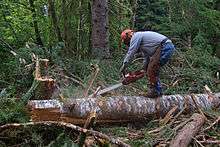Limbing
Limbing or delimbing is the process of removing branches from a tree trunk.[1]
.jpg)
In logging, limbing occurs on standing or felled trees.[2]
In fire prevention, limbing occurs on live trees to prevent the branches from being a fuel ladder, which is a term for vegetation that allows a fire to climb from the ground into the tree canopy. A California fire prevention guide recommends to "Remove all tree branches at least 6 feet [1.8 meters] from the ground" and "Allow extra vertical space between shrubs and trees."[3]
In British English, limbing can be synonymous with snedding. Alternatively, limbing can be used to describe the operation on larger branches, and snedding on smaller.
In logging
Options for cutting off the branches include chain saws, harvesters, stroke delimbers and others. Limbing can happen at the stump in log/tree length systems and cut-to-length systems or at the landing in whole-tree logging.

When the tree is lying on the ground, branches may be storing enormous potential energy through mechanical strain. When a branch is cut, often with a chain saw, this energy can be released suddenly and the branch can jump dangerously. In addition, a branch may be supporting the tree, and the tree can fall or roll when the branch is cut. For these reasons, limbing is a skilled operation requiring careful safety planning.
See also
References
- Logging Safety: A Field Guide, Section Four: Limbing and Bucking, New York State Department of Health
- Felling, Limbing and Bucking Trees; University of Missouri extension; by Hank Stelzer, Forestry State Specialist, School of Natural Resources
- Maintain Defensible Space, Ready For Wildfire, CAL FIRE